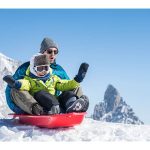When American kids do downhill skiing or snowboarding, they almost always wear a helmet, their parents say, but they’re far less likely to do so when cruising down a neighborhood hill on a sled.
That puts them at risk for serious head injuries, experts warn.
“Because sledding is so common, parents may overlook important safety concerns,” said Sarah Clark, co-director of the University of Michigan’s C.S. Mott Children’s Hospital National Poll on Children’s Health. “However, to avoid injuries, parents should ensure the sledding area is free of trees or other objects and has a flat runoff area at the bottom of the hill. Parents should also make sure children understand strategies to avoid collisions with other sledders.”
The safety warning follows Mott’s latest nationwide poll of U.S. parents. It included nearly 2,000 U.S. parents with at least one child between the ages of 3 and 18.
In all, 73% of respondents said their child always wears a helmet when downhill skiing or snowboarding, and 12% said their child wears a helmet some of the time when doing those activities.
But 70% said their child never does so when sledding — which parents said was the most common winter activity they expected their child to do.
Many parents don’t consider sledding as dangerous as other sports, even though more than 220,000 people were treated in U.S. emergency departments for sledding-related injuries between 2008 through 2017. Nearly 70% of these patients were 19 or younger.
Head injuries are the biggest risk if a child falls or collides with another sledder or object.
Even so, only 1 in 6 parents are likely to talk with their child about sledding safety rules such as how to avoid collisions and getting off the sled safely at the bottom of the hill, the survey found.
In contrast, 83% of parents said their child always wears a helmet when on a snowmobile, and 10% said their child sometimes does.
Clark emphasized the need for parental supervision when young children are doing outdoor winter activities.
“Very young children need supervision at all times during winter sports activities, either from a parent or another trusted adult,” she said. “This allows parents to ensure children are following safety rules, and to decide to leave if the area is getting too crowded or if other people are acting unsafely.”
Parents should use their judgment to decide whether older children require adult supervision or can/will follow safety measures on their own, she said.
If there is no adult supervision, children should have a cell phone and a parent should be available to respond quickly to a call about an injury or other emergency, Clark said.
More information
The National Safety Council has more on sledding safety.
SOURCE: University of Michigan, news release, Jan. 24, 2022
Copyright © 2025 HealthDay. All rights reserved.



-300x169.jpg)












